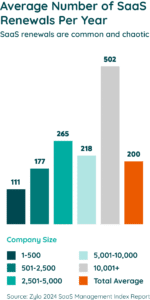Table of Contents
The world of SaaS management and SaaS contracts can be a complicated one. On our podcast, SaaSMe Anything, we regularly tackle important topics surrounding SaaS apps and SaaS management, providing insights and advice to IT, software asset management, and procurement leaders.
One area of particular menace is the rising cost of SaaS contracts. One way to control costs is by negotiating price caps into your SaaS contracts. Listen to the full episode below, or read on for the highlights on what price caps are, why they’re important, and how you can use them in your SaaS management strategies.
What Are Price Caps?
Price caps are when you set an annual limit on how much a SaaS company can increase its price. SaaS companies will often ask for pricing increases every year—especially when you’re going into renewal conversations. This is due to a variety of reasons, like inflation, cost of business increases, or new features, for starters. Price caps allow you to get ahead of those price increases and, well, cap them.
You can set price caps on both user license-based applications, like Salesforce, or consumption-based licenses. There are, however, some limitations to what you can negotiate a price cap for.
Typically, price caps cover existing capabilities in an application and capabilities that will be added in the foreseeable future, like a new wizard or email editor included in the platform. Price caps rarely cover large new features, especially ones that the company is charging for as upsells or add-ons.
Why Are Price Caps Important?
The importance of price caps is probably obvious to you, but let’s go over what makes them so beneficial, just in case. There are two main risks to not putting price caps in place.
For one, it means SaaS companies can just keep increasing their prices on you. Gartner projects that software spending is going to grow 15 to 20% annually for the foreseeable future. Setting a price cap can help you stay ahead of that budgeting curve.
Second, you can run into a budgeting nightmare without price caps. What if you’ve budgeted specific amounts for SaaS spending, then renewal conversations come up, and one of your vendors is increasing prices far beyond what you budgeted for? These are dangerous and all-too-common situations in companies that don’t set price caps.
Price caps keep you from hitting these nasty budgeting traps and getting caught up in a curve of ever-increasing SaaS spending. Setting price caps helps your Finance and IT departments because it gives the former more solid and consistent data while giving the latter more leverage to negotiate renewals.
The Ultimate Guide for Wildly Effective SaaS Renewals
Learn MoreHow Do I Set A Price Cap?
Alright, so you know what price caps are and you understand how important they are for your company, but how do you actually negotiate them? You can’t just tell your vendors to not raise prices, after all, so how do you get started and leverage the right price caps in the right conversations?
I recommend that you start price cap negotiations by looking at the Consumer Price Index (CPI). The CPI lets you look at inflationary pressures, which is a common driving force in SaaS price increases. If you look at the CPI and inflation rates, you can tell your SaaS vendors that they can’t increase the price beyond what the CPI is. This protects you from all the non-inflation price increase reasons we discussed earlier.
But what if they counter with new features, or added value from their program? This is where you do more research into your company’s numbers. You look at the solution, check the new features, and figure out what value you’re actually getting out of them. You want quantifiable metrics to verify a vendor’s claims about added value.
Maybe they’re telling the truth and the new features are very potent. In that case, negotiate a more fair price cap. If you find the vendor is embellishing some, then you have bargaining power.
For more tips on how to negotiate SaaS contracts, read the blog here.
Price Caps for Early Adopters
Another sticky situation to get caught in is being an early adopter for a SaaS app that is incredibly helpful and becoming very popular. Since you adopted early, the vendor probably gave you a great deal, but now they’re successful and don’t need your specific support as much.
They may come back and try to renegotiate a price in line with their modern contracts. You may balk at the idea of having your prices increased by so much—and you can certainly argue for a still-discounted price—but consider the opportunity costs of potentially walking away from this vendor. No matter where else you go, you’ll likely be paying more than you were to replace the software (and that’s assuming you even find a good replacement!).
For these situations, if you’re getting good value from the program, it may be a case of just biting the bullet and taking the increase. But that’s not to say you shouldn’t still negotiate and figure out together what the best price is considering your long-term standing relationship. The worst thing you can do is soil the relationship with the vendor and lose the value of the program.
Negotiating Price Caps Starts with Effective Contract and Renewal Management
Setting price caps for your SaaS contracts starts with good contract management – not to mention proactive renewal management. With any renewal, your goal is to keep costs flat or find ways to reduce what you’re spending. This means price caps are your friends.
That’s where a SaaS management platform (SMP) can come in handy. Let’s look at how those business practices fit in.
When it comes to your SaaS contracts, a SMP centralizes all the information you need to keep tabs on. Beyond contract details like renewal date, cost, and number of licenses, it also brings together utilization and spend data. All of this information is critical going into renewal negotiations. It’s quite a game-changer.
 Speaking of SaaS renewals, a SMP also enables you to be more proactive. No longer are you tracking down all that contract information. Using a tool produces efficiencies like:
Speaking of SaaS renewals, a SMP also enables you to be more proactive. No longer are you tracking down all that contract information. Using a tool produces efficiencies like:
- Automated renewal reminders
- Renewal calendar
- Workflows to reclaim licenses in anticipation of rightsizing at renewal
Instead of being caught on your heels and manually tracking down the right information, you can get a head start. We recommend giving yourself at least 90 days to prepare for a renewal, or even longer for core business apps like Salesforce. You’ll have the time to consider the right price cap for your organization, among other terms important to you.
“With what Zylo’s financial discovery has brought to the surface, our team was able to redirect their efforts away from updating columns and mining sheets for nuggets of information into taking decisive actions and getting results.” said Jon Alves, Category Manager, Technology at Momentive.
“We were able to dive into the data and start pulling together savings opportunities, renewal strategies that require enough runway to scope out what other alternative options there might be, maximize our current investments, and avoid unnecessarily adding licenses when adoption is low.”
To sum it up, a SaaS management platform gives you a complete picture of your SaaS applications. You can see your inventory and upcoming renewals, set automated alerts to stay ahead, centralize your contracts for review, and see application and usage data to fuel decision-making surrounding your rationalization, rightsizing, and renewals. If you want to negotiate healthy price caps and ensure your company is getting a good deal, you need a SaaS management platform.
Learn how Zylo helps companies effectively and proactively renew their SaaS. Request your personalized demo today.
ABOUT THE AUTHOR
Ben Pippenger
As Chief Strategy Officer, Ben is responsible for shaping and driving Zylo’s corporate strategy by monitoring and analyzing key market trends. As Zylo co-founder, he is passionate about the power of SaaS and helping organizations understand how they can manage, measure and maximize their investments for greater business impact. Ben is a self-proclaimed SaaS geek, with more than 20 years of B2B software experience, and a recognized SaaS and software management thought leader. Before founding Zylo, Ben held leadership roles in product and account management at Salesforce and ExactTarget.

